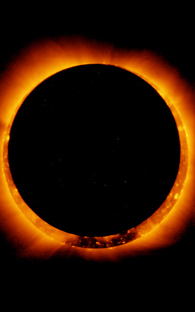
What a beautiful solar eclipse
Direction of Civil Protection called on the community not directly observe the solar eclipse that will be presented in Ciudad Juarez, said the Director General of Ecology and Civil Protection, Raul de Leon Apraez. .
It was necessary to use special eye protection, because to do so could have severe eye damage, even losing it.
He said that not just any sunglasses protect the eyes, so consider it necessary to ask the experts what type of material is indicated.
Another way to observe the eclipse is to make a hole in a card so that the light is projected on the floor.
The eclipse occurs when the Moon’s shadow does not cover completely the Sun and the star is seen as a luminous ring.
Was also observed in Baja California Norte, Baja California Sur, Chihuahua, Guadalajara, Mexico City and Monterrey.
IN ASIA AND THE UNITED STATES ALSO BE APPRECIATED
Millions of people in Asia and the western United States on Monday witnessed an annular eclipse of the sun, marveling at the strange spectacle of a “ring of fire” across the heavens.
The annular eclipse, in which the moon passes the sun, but leaving only a golden ring around its edges, was also witness to a singular event as virtually had a return in time, because it was seen first Monday morning in Asia and then in the last afternoon of Sunday in the western U.S..
In some parts of the United States were sold cameras with special filters to take pictures of the astronomical phenomenon. In several parts, as in Reno (Nevada) and Oakland (California), meetings were organized to witness the eclipse.

The ring of fire our beautiful world!
There were also people from neighboring states and Canada who traveled to Albuquerque, New Mexico, to enjoy the eclipse in one of the best places to watch. Older people threw shouts and the children screamed with excitement when the moon crossed the sun and started to form the halo of light.
In Japan, organized tours to better see the eclipse, either to pleasure boats and private aircraft. Similar events were held in China and Taiwan.
The eclipse was broadcast live on television in Tokyo, where there was not a solar eclipse since 1839. The Taipei Astronomical Museum opened before dawn on Monday and Hong Kong Space Museum set up telescopes with solar filters outside their building on the waterfront of Kowloon.
Japanese television sent teams to observe the phenomenon from the top of Mount Fuji. They also sent a team to a zoo south of Tokyo to capture the reaction of chimpanzees, but they do not seem to notice.
A light rain fell in Tokyo at the beginning of the eclipse, but the clouds thinned as the eclipse reached its maximum, which gives almost perfect condition.
“It was a very mysterious,” said Kaori Sasaki, who joined a crowd in downtown Tokyo to see the phenomenon. “I’ve never seen anything like this.”


